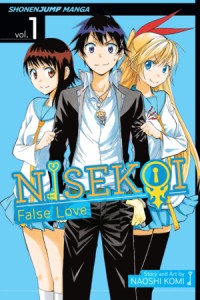By Naoshi Komi. Released in Japan by Shueisha, serialized in the magazine Weekly Shonen Jump. Released in North America by Viz Media. Translated by Camellia Nieh
Harems are a very popular genre, so popular they’re even called harems, rather than what they actually are – romantic comedy or romantic drama. You have a guy, or a girl, and their various love interests – when it’s more than two, that puts it in this genre. They are popular but also very dangerous to license long-term, especially for the West, where titles can come out in volume format over a year after fans have been shamelessly spoiled on the forums. Because let’s face it: 90% of readers are dissatisfied with the ending. Either the title leaves everything ambiguous (the so-called “no ending”), or the protagonist chooses the wrong one – i.e., the one the reader doesn’t prefer. This is true even if the correct choice has been signposted from the first chapter, so it must be even more frustrating for fans of Nisekoi, which theoretically did a much better job at keeping all its heroines as options till the end. That said, the series is still subtitled “False Love”. The False Love was the plot. And therefore the heroine… is the one we expected.
Therefore, this volume does its level best to shut down all the other pairings and show that, in fact, it’s Raku x Chitoge going forward. Chitoge is not the promise girl that we’ve been wondering about for the entire series – that’s Onodera – but she is the one that Raku decides he is in love with, despite the fact that, similar to Naru in Love Hina, she literally runs away from her feelings until there is nowhere left to run to. It’s very in character for Chitoge, and honestly everyone in this volume acts exactly as you’d expect them to. Tsumugi gets to have a cool fight, and finally show Claude that she is, in fact, a she (was anyone else reminded of that Night Court scene with Christine? No? Just me? OK…). Marika, who has always been the one whose feelings are RIGHT THERE, acts as an audience surrogate in telling Chitoge to man up and admit the truth. And Onodera… well, Onodera gets to cry, and also bake their wedding cake, something so mind-boggling that she has to textually tell the reader that she wanted to do this, and it wasn’t Raku or Chitoge’s idea. The nice girl to the end.
While we are starting to see a few series experiment with polyamory, it’s always in a “fantasy world” setting, and you’re not going to see it in modern-day Japan. And for those who want to ship the OT3 after the wedding… nope, we get a short epilogue showing Onodera’s daughter running into Raku and Chitoge’s son, and it’s obvious they haven’t met each other before. (Which is incredibly frustrating from anything other than a ‘dramatic irony’ perspective – must ALL harems never speak to each other again after the wedding, especially when they’re as close friends as Chitoge and Onodera were?) And so we’re left with a series that I enjoyed for 25 volumes… but is only going to be satisfying if you shipped Raku and Chitoge. This is the curse of all harem series, and it’s why they’re popular but hard to license, because hell hath no fury like a fanboy scorned. Still: Nisekoi was excellent. Good job.



